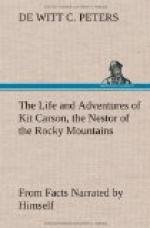General Kearney, seeing his officers thus shot down, drawing his sword, placed himself at the head of his remaining forces; and, though severely wounded, he made a desperate attempt to cause the enemy, once more, to retreat. At this crisis of affairs, Lieutenant Davidson arrived on the ground with two mountain howitzers. Before he could get his guns unlimbered and ready to commence firing, nearly every man he had to work them was shot down, being either killed or badly wounded. Following up their success, the Mexicans charged right up to the guns, and, with the lasso, unerring in their hands, captured the horses attached to, and, on the instant, made off with one of the guns. On reaching a distance of three hundred yards, they halted and prepared to turn the fire of the howitzer upon the Americans. From some unaccountable reason, it would not go off. Lieutenant Davidson did his utmost to prevent the loss of this gun, and after several narrow escapes from dangerous lance wounds, as his clothing and saddle sufficiently attested, he was finally stricken down, and nearly gave his life a sacrifice to his heroism.
After being thus badly cut up, and with not more than one or two officers left who had not been either killed or wounded, while the men had been handled with equal severity, the Americans were obliged to take refuge at a point of rocks which chanced to be near where their advance had been defeated. A rally was made at this place. The Mexicans, however, did not venture to attack them. Both sides were apparently weary of fighting for that day. The firing ceased, and soon after, night closed over the scene of the battle field.
These California Mexicans, previous to the war with the United States, were considered by the mountaineers as the bravest Spanish blood in the Mexican provinces. During the war, they proved that they had not been over-estimated, as they met their foes, at the commencement of hostilities, with a determination to win, or sell their lives dearly. The reason of this difference of courage in their favor over their countrymen who inhabited the internal States, is supposed to be owing to their opportunities for intercourse with the bold mariners from different countries who visited them in ships for the purpose of trade. This commerce consisted in the transporting into the country of such articles as arms, ammunition, groceries, and dry goods, for which were bartered, hides, tallow, and furs. The currency of California at that time was hides, which were estimated as so many dollars. The raising of cattle and horses was the leading employment of the people, and occupied most of their time. On the discovery of gold, these affairs underwent a change, and the rapid strides of civilization has left this people far in the minority. The horses of California were celebrated as being larger than the ponies of New Mexico, and also for being much fleeter of foot. The California rider, at that time, was looked upon as being unrivaled by those




